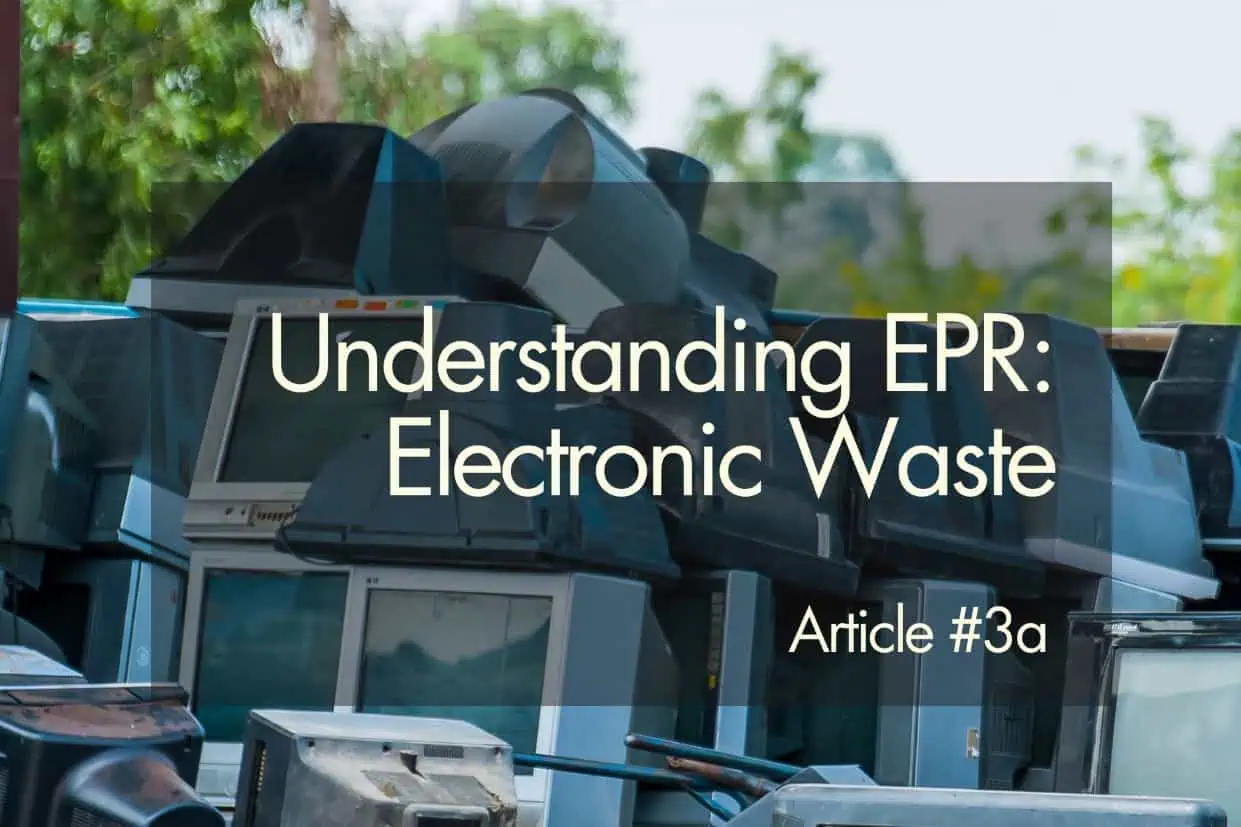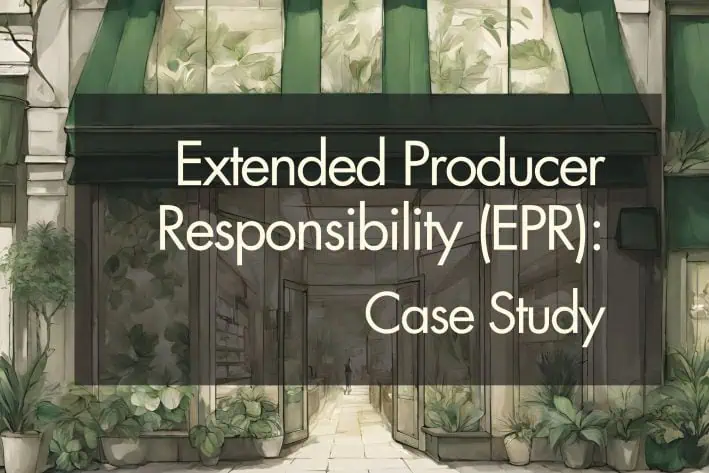What is Electronic Waste (E-Waste)
Electronic waste (e-waste) refers to any discarded electronic device that uses batteries or plugs into an outlet. This includes items such as smart devices, used cables, batteries, and fluorescent lights (Government of Canada, 2020). E-waste is a rapidly growing category of waste due to the increasing volume of discarded electronics.
In this article, we explore:
Why is Managing E-Waste Important?
With the advancements in smart appliances and connected devices, people in developed countries own more electronic devices than ever. As of 2022, Deloitte estimated that the average U.S. household has 25 connected devices, up from 11 in 2019 (Li, 2022). This surge is driven by the rapid adoption of items like smartwatches and smart speakers, which often have short update cycles. Many devices also face limited lifespans due to factors such as software support obsolescence, battery degradation, and poor repairability (Li, 2022).
Managing e-waste is crucial for several reasons:
- Environmental Protection: E-waste contains hazardous substances like mercury, lead, cadmium, beryllium, and arsenic, which can be harmful to the environment if not disposed of properly. For instance, fluorescent lights contain mercury and must not be thrown away with regular garbage (Government of Canada, 2020).
- Human Health: Improper disposal of e-waste can lead to the release of toxic chemicals, posing serious health risks to humans, including respiratory problems, skin conditions, and other health issues associated with exposure to these substances (Li, 2022).
- Resource Recovery: Electronic devices are composed of valuable materials such as steel, glass, copper, aluminum, iron, plastics, and precious metals. Proper management and recycling of e-waste allow these materials to be recovered and reused, reducing the need for new raw materials and minimizing environmental impact (Li, 2022).
- Waste Reduction: By donating or selling usable electronic items, we can extend their lifecycle and reduce the amount of e-waste, contributing to a more sustainable and circular economy (Government of Canada, 2020).
Extended Producer Responsibility: Management of E-waste in Canada
In Canada, electronic waste (e-waste) is managed through Extended Producer Responsibility (EPR) programs implemented in all provinces except Nunavut, due to the complexities of adequate infrastructure in this geographic location (Government of Canada, 2023). EPR mandates that producers take responsibility for the entire lifecycle of their products, including end-of-life management. This legislation is predominantly set at the provincial level, while the federal government supports harmonization and standardization across the country (Schroeder & Schroeder, n.d.).
E-waste, which includes discarded electronic devices like smart devices, batteries, and fluorescent lights, contains hazardous substances such as mercury, lead, and cadmium. Proper management is crucial to mitigate environmental and health risks (Li, 2022). To address these challenges, the Canadian Council of Ministers of the Environment (CCME) endorsed a National Model for E-waste Stewardship in 2004, developed by Electronics Product Stewardship Canada (EPSC), to guide provincial programs and harmonize strategies (Schroeder & Schroeder, n.d.).
The Electronic Products Recycling Association (EPRA), established in 2011, oversees the implementation of e-waste recycling standards and ensures compliance with provincial regulations (Schroeder & Schroeder, n.d.). EPRA operates as a Producer Responsibility Organization (PRO), a non-profit entity that helps producers fulfill their EPR obligations by managing the collection, recycling, and disposal of electronic waste on their behalf. This allows producers to leverage shared infrastructure and expertise, ensuring efficient and compliant recycling processes.
Ontario transitioned to an Individual Producer Responsibility (IPR) model on January 1, 2021, under the Resource Recovery and Circular Economy Act (Government of Ontario, n.d.). This model, overseen by the Resource Productivity and Recovery Authority, requires individual producers to manage their products’ end-of-life stages, either by internalizing recycling costs or imposing a recycling fee per unit sold (Government of Ontario, n.d.). Several PROs still provide operational support for electronics producers in Ontario.
Infrastructure Supporting E-waste EPR in Canada
Overview of E-waste Management
In Canada, there is extensive infrastructure for managing e-waste. It involves multiple stakeholders, including provincial governments, Producer Responsibility Organizations (PROs), and various non-profit organizations (OECD, 2016).
Provincial Government Role
Provincial governments are responsible for developing, monitoring, and regulating Waste Electrical and Electronic Equipment (WEEE) (Government of Canada, 2023). They set performance targets for designated materials, review and approve industry stewardship plans, oversee program operations, and enforce compliance measures (OECD, 2016).
Producer Responsibility Organizations (PROs)
Producers, which include manufacturers and first importers, can either fund and operate their own WEEE stewardship programs or register with a PRO. PROs act as stewardship agents representing producers, managing the collection, recycling, and disposal of e-waste (OECD, 2016). If used, they are also responsible for reporting designated product sales and fees to oversight agencies (OECD, 2016). PROs also manage authorized service providers and conduct public information and education campaigns (OECD, 2016).
Examples of PROs
- Electronic Products Recycling Association (EPRA): EPRA is a national industry-led non-profit organization that oversees e-waste recycling standards and compliance across Canada (Government of Canada, 2023). EPRA registers and contracts with authorized WEEE processors and recyclers, ensuring they meet health and environmental criteria set by the Recycler Qualification Office. EPRA also manages public reporting and education efforts.
- Electronic Recycling Association (ERA): Founded in 2004, ERA addresses e-waste and the digital divide by recovering, refurbishing, and reusing IT equipment (Electronic Recycling Association, n.d.). ERA provides charitable groups with donated IT assets and partners with certified recycling organizations for items that cannot be repurposed. ERA emphasizes reuse before recycling and offers data destruction services to manage retiring IT equipment.
- Ontario Electronic Stewardship (OES): OES, developed in collaboration with Waste Diversion Ontario and the Ontario government, facilitates the recycling of over 44 categories of electronic waste (EZCycle, n.d.). From 2009 to 2012, OES helped divert over 200 million pounds of e-waste from landfills. The organization collaborates with more than 600 service providers across Ontario to promote responsible reuse and recycling of end-of-life electronics.
- ReStore: ReStore, part of Habitat for Humanity, collaborates with Ontario Electronic Stewardship to collect e-waste, reduce landfill waste, and ensure responsible recycling (Habitat for Humanity, n.d.). They work with local recycling companies to manage electronic waste within Canada.
Monitoring and Reporting
Producers and PROs are required to report designated product sales and fees to the government oversight agency monthly and provide annual reports on overall program performance (OECD, 2016). This reporting system is intended to maintain accountability and track if e-waste management programs meet performance targets.
Fees and Economic Efficiency of EPR Models for E-Waste in Canada
Environmental Handling Fees (EHFs):
Environmental Handling Fees (EHFs) are a vital component of the funding mechanism for Extended Producer Responsibility (EPR) programs in Canada (OECD, 2016). These fees are paid by producers and subsequently passed on to consumers at the point of purchase. EHFs vary by province, product weight, quantity, and composition (OECD, 2016).
EHFs ranged from $0.80 in Saskatchewan and Manitoba to $3.50 for desktop computers in Ontario and $10.50 in the Northwest Territories (The Source, n.d.). For computer printers, fees ranged from $3 in Alberta to $8 in the Northwest Territories (The Source, n.d.). These fees are regularly reviewed and adjusted by bodies such as the Electronic Products Recycling Association (EPRA) to ensure they adequately cover program operation costs (OECD, 2016).
Ontario’s Switch to Individual Producer Responsibility (IPR):
The new Electrical and Electronic Equipment (EEE) Regulation in Ontario makes producers individually accountable for recycling their products (RPRA, n.d.). Producers have the option to either absorb the recycling costs or pass them on to customers via EHFs. Producers must meet specific recycling targets, starting at 55% and increasing to 70% by 2025. However, the regulation’s language about making “best efforts” has raised concerns about the enforceability and consistency of these targets (King, 2021).
Ontario’s adoption of the Individual Producer Responsibility (IPR) model has led to inconsistencies in EHFs, causing confusion among consumers (EPRA Ontario, n.d.). Fees for the same products can vary widely between retailers, with some charging less than a dollar and others over CAD 30 (King, 2021). Consumers have expressed dissatisfaction with these discrepancies, feeling unfairly charged (King, 2021).
Economic Efficiency of E-waste EPR Programs:
Collection Rates and Cost Efficiency:
From 2013 to 2020 e-waste collection rates declined across Canada, with the exception of Québec, which saw a significant increase due to harmonized EPR programs and proactive regulations (Adu-Darko et al., 2024).
E-Waste Collection Rates by Province (2013-2020):
Amount of E-Waste Collected (kg/capita) from 2013 to 2020. Source: Adu-Darko et al., 2024.

Cost Efficiency of E-Waste Management (2013-2020):
1. Overall Program Costs (Adu-Darko et al., 2024): The program cost per tonne of e-waste was generally between $1,000 to $1,730 CAD.
2. Provincial Costs (where available) (Adu-Darko et al., 2024):
Saskatchewan (SK):
– Average cost per tonne: $1,457.6 CAD
– Budget allocation: 24.6% on e-waste collection
Prince Edward Island (PEI):
– Average cost per tonne: While it’s difficult to find exact figures, studies indicate that program cost per tonne increased by 16.5% from 2013 to 2020.
Quebec (QC):
– Average cost per tonne: $1,222.88 CAD
– Budget allocation: 19.2% on collection
This data reveals that provinces with higher e-waste volumes managed per steward, such as Québec, tend to have lower costs per tonne, highlighting the economic benefits of scale. In contrast, provinces with lower collection rates and higher costs per tonne may need to optimize their stewardship models and increase public awareness to improve efficiency.
Logistical Support and Efficiency:
Regular pick-ups and adequate storage facilities are essential for efficient e-waste management. However, some municipalities face logistical challenges that affect overall efficiency. Grouping provinces by geographical proximity and encouraging collaborative approaches can enhance economic efficiency (Adu-Darko et al., 2024) (Ali, 2023). Western provinces, in particular, show potential benefits from coordinated waste management systems.
Local Economic Impact:
EPR programs can support local economies by creating jobs in recycling and refurbishing activities. However, PROs prefer larger recyclers over local nonprofits, potentially affecting local employment (Badami & Leclerc, 2023). Municipalities favor when PROs work with local recyclers, indicating that integrating local economic benefits can enhance the programs’ economic efficiency.
Transparency and Fairness:
The lack of transparency in financial agreements between PROs and municipalities has led to dissatisfaction and perceptions of unfairness. More standardized and open financial arrangements could improve trust and perceived economic efficiency. Confidential agreements make it difficult to assess whether the polluter pays principle is effectively implemented, raising questions about the overall economic efficiency of the EPR system (Badami & Leclerc, 2023).
E-Waste Management and Illegal Export
E-Waste Management through EPR Programs
E-waste has seen a dramatic increase in production per capita from 8.3 kilograms in 2000 to 25.3 kilograms in 2020 (Ali, 2023). Managing this waste has presented challenges due to inconsistent and often inadequately enforced regulations at the federal, provincial, and territorial levels (Ali, 2023). While all provinces and territories, except Nunavut, have their own regulated EPR programs, progress has been sluggish.
Illegal Export of E-Waste
One of the most pressing issues is the illegal export of hazardous e-waste to developing countries. Despite international regulations like the Basel Convention, which seeks to control the movement of hazardous wastes, violations are frequent (University of British Columbia, n.d). A substantial portion of Canada’s e-waste ends up in poorly managed landfills in developing countries, where it is often processed under unsafe conditions (University of British Columbia, n.d).
Key Points of Concern:
- Volume of E-Waste: Global e-waste production is rapidly increasing. In 2019, the world produced 53.6 million tonnes of e-waste, with projections reaching 74.7 million tonnes by 2030. Canada generated 638,300 tonnes in 2017, with expectations to increase significantly by 2025 (Li, 2022).
- Health and Environmental Hazards: E-waste contains toxic substances such as mercury, lead, and cadmium, posing severe health risks. Improper disposal methods, like burning or using acid baths to extract precious metals, release these toxins into the environment, contaminating soil and water, and harming local ecosystems (University of British Columbia, n.d) (Li, 2022).
- Improper Disposal: Developing countries in East and South-East Asia, Africa, and India are popular destinations for e-waste. Workers, often including children, are exposed to harmful chemicals without adequate protection, leading to serious health issues. Informal processing methods used in these regions also contribute to environmental degradation (University of British Columbia, n.d) (Li, 2022).
- Regulatory and Enforcement Challenges: Canada’s enforcement of international regulations like the Basel Convention has been criticized as insufficient. Instances of Canadian companies being fined for illegal e-waste exports highlight ongoing challenges in effectively managing hazardous waste (University of British Columbia, n.d).
Recommendations for Improvement:
E-Waste Management through EPR Programs
– Promoting the right to repair and increasing investment in repair and refurbishment infrastructure can extend the lifespan of electronic products, reducing the volume of e-waste. This requires coordinated efforts from governments, original equipment manufacturers (OEMs), and consumers. This approach not only conserves resources but also provides economic benefits by creating jobs in the repair and refurbishment sectors (Li, 2022) (Sawicki, 2022) (University of Waterloo, 2023).
2. Public Awareness and Education:
– Enhancing public awareness about proper e-waste disposal and the benefits of repair and refurbishment is crucial. Informing Canadians about responsible management of their electronic devices can significantly reduce the e-waste footprint waste (University of British Columbia, n.d).
3. Comprehensive Data Collection:
– Improving data collection on the sources and types of e-waste, as well as the environmental and economic impacts of e-waste management practices, can inform better policy decisions and management strategies (University of Waterloo, 2023).
4. Collaborative Efforts and Policy Implementation:
– Encouraging collaboration among various stakeholders, including governments, industry, and non-profits, can improve the effectiveness of e-waste management programs. Implementing policies like the Extended Producer Responsibility (EPR) ensures manufacturers are accountable for the entire lifecycle of their products (University of British Columbia, n.d) (Ali, 2023).
5. Access to Environmentally Friendly Options:
– Ensuring all Canadians have access to environmentally friendly disposal and recycling options is essential. This includes creating long-term incremental approaches to sustainable electronic recycling and facilitating access to green alternatives (University of British Columbia, n.d).
To learn more about other EPR systems, please click this link to return to the main article.

Deborah King
Deborah is a sustainable fashion expert located in Toronto, Canada. She’s an Industrial Engineer with a post-grad in Sustainable Fashion Production. She grew up on the tiny island of Tortola in the British Virgin Islands, and has been sewing her own clothing since the age of 10. She founded Global Measure to help authentically sustainable and ethical fashion businesses stand out from the greenwashing noise through third-party certification.
Curious to explore EPR further or interested in potential collaborations? Dive into our comprehensive Case Study for a deeper understanding.
References:
Adu-Darko, H., Chowdhury, R., Mim, S. J., Tasnim, A., and Tsun Wai Ng, K. (May 2024). Influence of Canadian provincial stewardship model attributes on the cost effectiveness of e-waste management. Retrieved on May 13, 2024 from https://www.sciencedirect.com/science/article/pii/S0301479724009319
Ali, Saidia (August 2023). How to manage our growing pile of electronic waste. Retrieved on May 10, 2024 from https://policyoptions.irpp.org/magazines/august-2023/electronic-waste-management/
Badami, M. G., and Leclerc, S. H. (May 2023). Extended producer responsibility: An empirical investigation into municipalities’ contributions to and perspectives on e-waste management. Retrieved on May 10, 2024 from https://onlinelibrary.wiley.com/doi/full/10.1002/eet.2059
Electronic Recycling Association (n.d.). Recycling With A Difference. Retrieved on May 1, 2024 from https://www.era.ca/about-us/
EPRA Ontario (n.d.). EPRA/Recycle My Electronics is your national not-for-profit organization providing trusted, proven program management for electronics recycling across Canada. Retrieved on May 2, 2024 from https://epraon.ca/
EZCycle (n.d.). Supporting The Ontario Electronics Stewardship Program. Retrieved on May 1, 2024 from https://ezcycle.ca/oes/
Government of Ontario (n.d.). Resource Recovery and Circular Economy Act, 2016, S.O. 2016, c. 12, Sched. 1. Retrieved on May 2, 2024 from https://www.ontario.ca/laws/statute/16r12
Government of Canada (May 2020). E-waste. Retrieved on May 2, 2024 from https://ised-isde.canada.ca/site/office-consumer-affairs/en/be-green-consumer/e-waste
Government of Canada (January 2023). Inventory of recycling programs in Canada. Retrieved on May 2, 2024 from https://www.canada.ca/en/environment-climate-change/services/managing-reducing-waste/overview-extended-producer-responsibility/inventory-recycling-programs.html
Habitat for Humanity (n.d.). E-waste: Don’t know what to do with your old and used electronics? Retrieved on May 1, 2024 from https://habitat4home.ca/restore/e-waste/
King, Angelina (Feb 18, 2021). Ontario’s new electronics recycling fees causing confusion for some customers. Retrieved on May 1, 2024 from https://www.cbc.ca/news/canada/toronto/ontario-s-new-electronics-recycling-fees-confusion-customers-1.5917581
Organisation for Economic Cooperation and Development (OECD) (Sept 2016). Extended Producer Responsibility: Updated Guidance for Efficient Waste Management. Retrieved on May 1, 2024 from https://www.oecd-ilibrary.org/environment/extended-producer-responsibility_9789264256385-en
Resource Productivity & Recovery Authority (RPRA) (n.d.) Understanding Ontario’s EEE Regulation. Retrieved on May 1, 2024 from https://rpra.ca/learn/understanding-ontarios-new-eee-regulation/
Sawicki, A. (June 2022). E-Waste Management in Ontario: Correcting Past Stumbles with Policy Lessons from the EU. Retrieved on May 10, 2024 from https://carleton.ca/caneunet/wp-content/uploads/Sawicki-Alexander-E-Waste-Management-Ontario-EU.pdf
Schoeder & Schroeder (n.d.). E-waste management in Canada. Retrieved on May 2, 2024 from https://schroeder-inc.com/white-papers/e-waste-management-in-canada/
The Source (n.d.). Environmental Handling Fees. Retrieved on May 1, 2024 from https://www.thesource.ca/en-ca/envHandlingFee
Tom Li (April 2022). E-waste, tech’s big dirty secret. Retrieved on April 30, 2024 from https://www.itworldcanada.com/article/e-waste-techs-big-dirty-secret/481142
University of British Columbia (n.d). The Story Of Canada’s Digital Dumping Ground. Retrieved on May 10, 2024 from https://cases.open.ubc.ca/w17t2cons200-26/
University of Waterloo (May, 2023). Canadian e-waste has tripled, new study finds. Retrieved on May 10, 2024 from https://uwaterloo.ca/news/media/canadian-e-waste-has-tripled-new-study-finds





